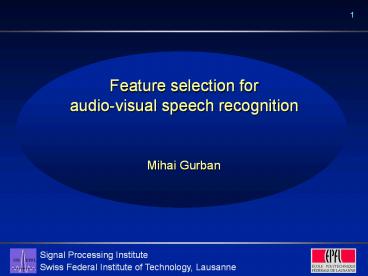MMM PowerPoint PPT Presentation
Title: MMM
1
Feature selection for audio-visual speech
recognition
Mihai Gurban
2
Outline
- Feature selection and extraction
- Why select features?
- Information theoretic criteria
- Our approach
- The audio-visual recognizer
- Audio-visual integration
- Features and selection methods
- Experimental results
- Conclusion
3
Feature selection
- Features and classification
- Features (or attributes, properties,
characteristics) - different types of measures
that can be taken on the same physical phenomenon - An instance (or pattern, sample, example) -
collection of feature values representing
simultaneous measurements - For classification, each sample has an associated
class label - Feature selection
- Finding from the original feature set, a subset
which retains most of the information that is
relevant for a classification task - This is needed because of the curse of
dimensionality - Why dimensionality reduction?
- The number of samples required to obtain accurate
models of the data grows exponentially with the
dimensionality - The computing resources required also grow with
the dimensionality of the data - Irrelevant information can decrease performance
4
Feature selection
- Entropy and mutual information
- H(X), the entropy of X the amount of
uncertainty about the value of X - I(XY), the mutual information between X and Y
the reduction in the uncertainty of X due to the
knowledge of Y (or vice-versa) - Maximum dependency
- One of the frequently used criteria is mutual
information - Pick YS1YSm from the set Y1Yn of features, such
thatI(YS1,YS2,, YSm C) is maximum - How many subsets?
- Impossible to check all subsets, high number of
combinations - As an approximate solution, greedy algorithms are
used - The number of possibilities is reduced to
5
A simple example
- Entropies and mutual information can be
represented by Venn diagrams - We are searching for the features YSi with
maximum mutual information with the class label - Assume the complete set of features is
6
A simple example
7
A simple example
8
A simple example
9
A simple example
10
Which criterion to penalize redundancy?
- Many different criteria proposed in the
literature - Our criterion penalizes only relevant redundancy
11
Solutions from the literature
- Natural DCT ordering
- Zigzag scanning, used in compression (JPEG/MPEG)
- Maximum mutual information
- Typically the redundancy is not taken into
account - Linear Discriminant Analysis
- A transform is applied on the features
12
Our application AVSR
- Experiments on the CUAVE database
- 36 speakers, 10 words, 5 repetitions per speaker
- Leave-one-out crossvalidation
- Audio features MFCC coefficients
- Visual features DCT with first and second
temporal derivatives - Different levels of noise added to the audio
13
The multi-stream HMM
- Audio-visual integration with multi-stream HMMs
- States are modeled with gaussian mixtures
- Each modality is modeled separately
- The emission likelihood is a weighted product
- The optimal weights are chosen for each SNR
14
Information content of different types of features
15
Visual-only recognition rate
16
Audio-visual performance
17
AV performance with clean audio
18
AV performance at 10db SNR
19
Noisy AV and visual-only comparison
20
Conclusion and future work
- Feature selection for audio-visual speech
recognition - Visual-only recognition rate not a good predictor
for audio-visual performance because of
dimensionality - Maximum audio-visual performance is obtained for
small video dimensionalities - Algorithms that improve performance at small
dimensionalities are needed - Future work
- Better methods to compute the amount of
redundancy between features

